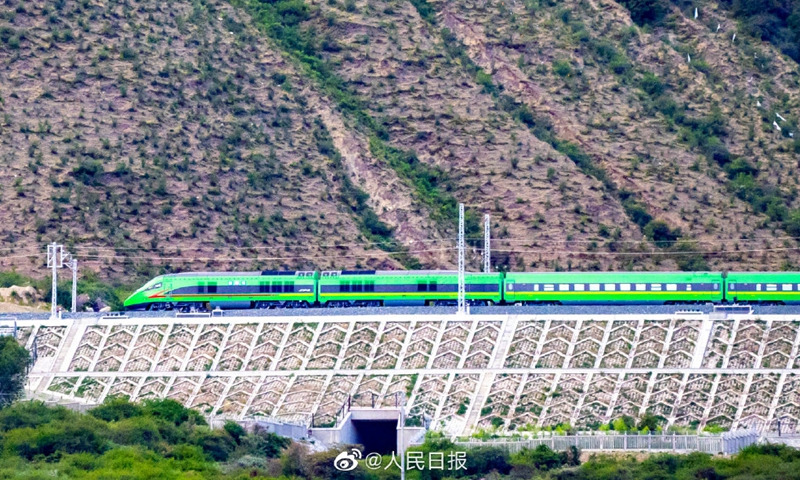As India, China conflict simmers over the disputed Himalayan border in Ladakh, it seems that China has sent out a clear message to India as PLA has conducted more than 100 drills so far this year close to LAC in the Tibet region.
Beijing also operationalized a fully-electrified bullet train service between Tibet’s capital Lhasa and Nyingchi, a strategically located border town opposite India’s Arunachal Pradesh, on June 25.
South China Morning Post reported quoting the Chinese Defense Ministry that the PLA has carried out more than 100 joint exercises so far this year and has stepped up its military drills along the Line of Actual Control (LAC).
This shows, despite the February disengagement in the Pangong Tso in eastern Ladakh, China carries on with its concerted efforts to expand its military capabilities along the disputed Himalayan border.

Reports suggest that following the Galwan Valley clash on June 15 last year, China increased its presence along the border in a well-planned manner.
China Raising Tibetan Militias
Chinese military “operations had continued despite Covid-19 pandemic and included a ‘record-breaking’ high-altitude drill involving more than 1,000 troops from 20 units earlier this month”, Military spokesman Ren Guoqiang said at a press conference on June 24.
Conducted in Tibet Autonomous Region, the high-altitude drill was intended to boost Chinese troops’ combat capabilities in extreme weather conditions. It was organized as part of the centenary celebrations of the Communist Party.
Part of China’s Western Theatre Command, the Tibet Military Region oversees the disputed border with India.
Chinese #PLA Tibet Military Command recently sent troops to high-altitude region at 4,700m elevation at night for infiltration exercises behind the enemy line, destroyed opposing armored vehicles and launched strikes on enemy headquarters. https://t.co/5q43OE6COO pic.twitter.com/Y9wDt5M5kM
— Global Times (@globaltimesnews) June 2, 2020
Moreover, the Chinese PLA has started raising Tibetan militia groups as a response to India’s recruitment of exiled Tibetans, Song Zhongping, a Hong Kong-based military commentator was quoted as saying.
He said local militias would help PLA to conduct reconnaissance and logistics operations. The physical fitness of Tibetans makes it easier for them to acclimatize to the high altitude than regular PLA soldiers, Song believed.
A few days ago, China deployed the first batch of militias comprising Tibetan youths in the strategic Chumbi Valley. They have been provided with drones as well as traditional means such as horses and mules for logistics supply.
Apart from Chumbi Valley, China has deployed 200 locals in various locations such as Yutung, Cheema, Rinchengang, PB Thang and Phari, according to WION News.
Bullet Train To Lhasa
China on June 25 operationalized its first fully electrified bullet train service connecting Tibetan capital Lhasa and Nyingchi, opposite India’s Arunachal Pradesh state.
The train commenced its operations in the southeastern part of Qinghai-Tibet Plateau in the morning, according to the state-run Xinhua news agency.
State-owned Global Times said the Lhasa-Nyingchi section of the Sichuan-Tibet Railway runs in 435.48 kilometers. Powered by both internal combustion and electricity, it has a design speed of 160 kilometers per hour on its side.

The work of the track was completed just a few months back, The Eurasian Times reported in April this year.
The train reaches Nyingchi from Lhasa in 3 hours and 29 minutes and to Shannan from Lhasa in 1 hour and 10 minutes. As a symbol of an improved transportation network, it reduces the travel time from Shannan to Nyingchi from 6 hours to approximately 2 hours.
Is India Lagging Behind China?
Citing the Xinhua news agency, EurAsian Times reported that the construction of the high-speed railway line began in 2014. According to Jayanta Kalita, Editor of The Eurasian Times, “China has rapidly improved infrastructure in areas close to the Line of Actual Control, its de facto border with India.
“It has expanded the railway network connecting the remote parts of Tibet with mainland China, a move to assert Beijing sovereignty and supremacy and counter Western narrative in support of the Tibetans’ right to self-determination.
The PLA on Wed released a video of Tibet military command’s live-fire drill on the plateau. PLA also conducted a drill of airborne troops. Yes, these are all aimed at the situation on China-India border. The Indian army will either stop provoking or be prepared to be defeated. pic.twitter.com/124h0ccu8h
— Hu Xijin 胡锡进 (@HuXijin_GT) September 9, 2020
“In contrast, India’s border infrastructure is limited to building roads, bridges, and a few tunnels only. A vast area of Arunachal Pradesh in India’s strategically important Northeast, is still devoid of proper road links let alone railway tracks.
“In 2015, India had extended the rail network up to Arunachal’s Naharlagun, just across the Assam border. Since then there has been little progress to extend the network even as there has been a bombardment of development on the Tibet side.
“Even Arunachal chief minister Pema Khandu stressed the need to link the beautiful town of Tawang, which houses the world’s second-largest monastery, with a railway network,” Kalita said.
Written by Kanika Sachdeva
Read More
- WATCH: Russian Su-30 Fighter Forces F-35 Stealth Jets To Retreat In Their ‘First-Ever Encounter’
- Despite World’s Biggest Navy, Why China Will Struggle To Match Indian Submarines In The Indo-Pacific?




